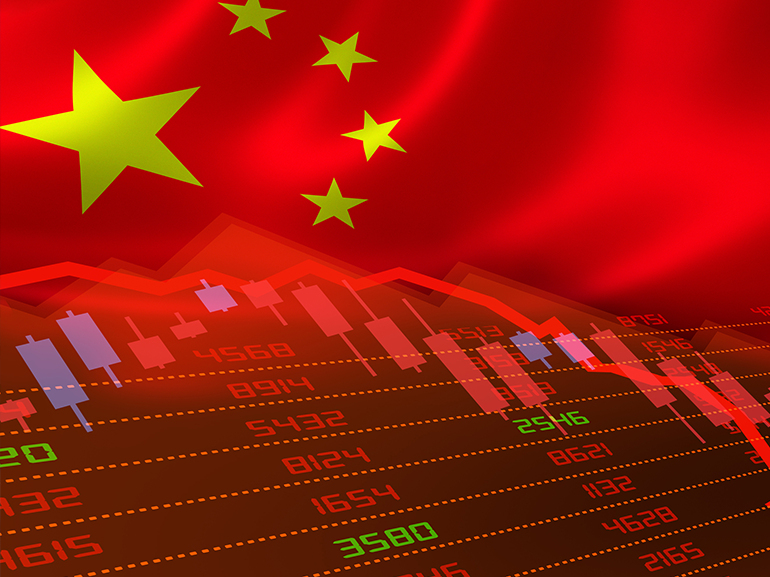China Deflation Amplifies Moody’s Downgrade
China’s CPI change in July turned negative for the first time in over two years, leading to both China’s Shanghai Composite to drop 0.5% and Hong Kong’s Hang Seng (HSI) to lose 0.2% in trading on Wednesday, August 9. The inflation figures were seen increasing worries about China's growth prospects and how effective traditional stimulus measures are. Data showed Chinese PPI also fell more than anticipated, with a drop of 4.4% versus the expected 4.1% figure.
The news came after markets were already worried following Moody's downgrading of the credit ratings of 10 major US banks, which was seen as the catalyst to push US stocks lower on Tuesday, August 8. The KBW Regional Banking index, an index weighting 24 banking stocks to gauge the banking industry, fell 1.1%, while the benchmark S&P 500 (USA 500) was off 0.4% following the news. The DJIA (USA 30) shed 0.5%, and the Nasdaq (US-TECH 100), down nearly 0.8% as investors feared for the health of US banks and the economy more broadly. Various sectors, including financials, materials, and consumer discretionary experienced declines, with some notable exceptions in energy and healthcare.

Are US Regional Banks Still at Risk?
Moody's cut the credit rating of many mid-sized banks and placed several larger banks under negative review. Among the ten banks that saw their ratings cut were Bank of New York Mellon (BNY Mellon), US Bancorp,(USB), and State Street (STT). The rating agency also lowered its outlook for 11 banks, including Capital One (COF), PNC Financial (PNC), and Fifth Third Bancorp (FITB). Moody’s said that banks in the US continue to face risks from Fed’s interest rates and asset-liability management and expected asset quality to decline as the US is seen facing a mild recession at the start of 2024.
Shares in many of the aforementioned banks closed over 1% lower on Tuesday, August 8. Moody's believes that the Fed's aggressive monetary policy continues to have a material impact on the US banking system. Analysts, however, pointed out that the move likely was in response to rising stock prices in those banks in the wake of better-than-expected earnings. The quarterly reports showed a troublesome trend, where smaller banks attracted deposits by increasing interest payments, cutting profitability. As a result, many of the banks cut their guidance for the year. Additionally, regulators want to implement a new complex set of bank standards. Analysts also expressed concern that slower lending from smaller banks could impact economic growth.
China Data Add to Concerns
Declines in equities from the US were followed by further negative news out of China, following a larger-than-expected drop in trade on Tuesday, August 8. Moreover, issues with one of China's largest homebuilders, Country Garden, which saw its shares fall 8.9% in Wednesday trading, added to the gloomy outlook. Still, while China's inflation contracted, it wasn't as much as initially forecast. On the other hand, producer prices fell more than forecast. But the Chinese yuan (USDCNH) rose against the dollar thanks to a higher fixing, with the pair having fallen to a maximum of 0.38% on Wednesday’s session by the time of writing.
Producer prices fell 4.4% compared to a year ago, which was worse than the 4.1% decline that was forecast. With both CPI and PPI in deflation territory, it points to continued weakening in the economic mentum due to slow domestic demand. Conversely, it might put more pressure on the government to add to fiscal stimulus. This lacklustre domestic demand has been persistent since the pandemic. These figures come on the heels of trade data that saw both foreign and domestic demand take a sharp plunge. Exports in July fell 14.5% compared to the prior year, while imports fell 12.4% in the same period, with both readings being worse than analysts had expected. It was estimated that real trade volumes declined by around 0.4%. (Source:CNBC)
The concerns over slow demand from China, the world's largest importer of crude oil (CL), may have also driven oil prices slightly lower on Wednesday, August 9. The upside to oil markets was seen limited in analysts' estimates, who cited slowing demand in the US and Europe due to interest rate hikes. In addition, China’s Tuesday's trade data showed that the country imported 18.8% less crude in July than the previous month, the lowest amount since the start of the year. Notably, oil prices were seen trading as high as $83 per barrel at the time of writing.
Conclusion
US and Chinese equity indices fell after Moody's cut the rating for several US banks, followed by China reporting that it had entered deflation as its CPI change turned negative and producer prices fell more than expected. The latest data was seen as deepening worries about China's growth prospects. The last time China recorded a drop in inflation was in February 2021. How will markets respond to these shifts going forward?
